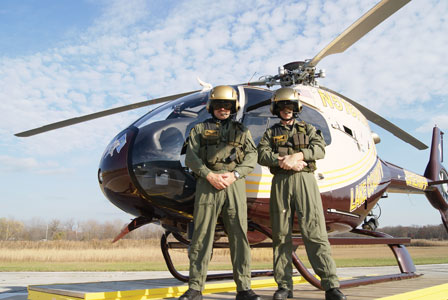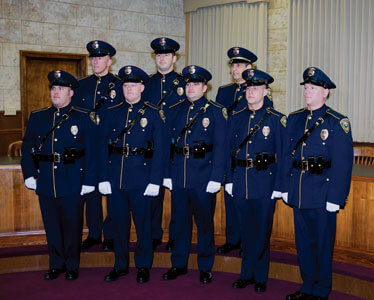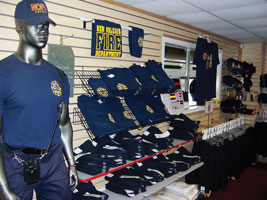When personal safety is threatened or justice needs to be served, the public turns to the authorities for help. Whether it’s the police department, the Coast Guard, the United States Marshals or another government agency, the public trusts that they’ll have help whenever and wherever they need it. Yet, the average citizen doesn’t often consider the lengths to which these groups go to protect the public, nor what happens when the people who help others need help themselves.
 When a police officer loses sight of a suspect during a foot pursuit, who steps in and catches him? When a boater is in distress and the Coast Guard can’t respond quickly enough, who comes to the rescue? When the Drug Enforcement Administration needs an extra pair of eyes, who do they call? These groups all know a little secret: When their own resources and abilities won’t suffice to protect the public or to serve justice, they turn to the skies for help from some extraordinary assistants.
When a police officer loses sight of a suspect during a foot pursuit, who steps in and catches him? When a boater is in distress and the Coast Guard can’t respond quickly enough, who comes to the rescue? When the Drug Enforcement Administration needs an extra pair of eyes, who do they call? These groups all know a little secret: When their own resources and abilities won’t suffice to protect the public or to serve justice, they turn to the skies for help from some extraordinary assistants.
These partners in the sky possess astonishing abilities: flight, night vision, enhanced hearing and more. They may look like ordinary people, but when duty calls, they ascend toward the clouds, donning specialized garments that give them protection from fire and headwear that keeps rogue goose parts out of their eyes. They are the brave men and women of airborne law enforcement.
What’s a typical day like in the life of an airborne law enforcement officer? According to Randy Phillips, sergeant of the Lake County, Ind., Police Department Aviation Unit, the days are anything but typical, but they almost always involve aerial patrol. “We provide air support for our department and the 17 other cities and towns that are in Lake County, Indiana. Basically, we do an aerial patrol pretty much every day,” says Sgt. Phillips.
As one of just two airborne law enforcement units in Indiana (the other in Indianapolis), the Lake County Aviation Unit has a lot of ground to cover. The unit patrols the entire county while also listening to other departments on the radio. If departments have calls for service, the aviation unit responds. Sgt. Phillips explains, “Whether it’s hold-up alarms for banks, general alarms, any type of car pursuits or foot pursuits, we respond to those. We also get called out to the neighboring counties if they’re looking for murder suspects.”
Additionally, the aviation unit helps government agencies, including the United States Coast Guard; the Drug Enforcement Administration; the Bureau of Alcohol, Tobacco, Firearms and Explosives; and the United States Marshals. These groups often request the aviation unit’s assistance with surveillance work and tracking suspects.
Being airborne, the unit has many advantages over units on the ground. The helicopters are able to fly over areas, like dense forests, that are less accessible to officers in their squad cars or on foot. Additionally, the helicopters can quickly cover a large area. They are equipped with thermographic cameras as well as night vision devices that enable them to easily spot suspects weaving around buildings or among trees. The aviation unit may even be tasked with transporting dangerous criminals. “We recently had a bunch of high-profile gang leaders that went to federal court, so we provided aerial support with the transportation from our county jail to the federal court up in Hammond and then on the way back,” says Phillips.
Catching bad guys is all in a day’s work for Sgt. Phillips and the other members of the aviation unit, but the group is also devoted to helping the most vulnerable members of their communities. The aviation unit, along with local fire departments, helps with a program called Project Lifesaver, which is aimed at locating individuals who, for one reason or another, have wandered from home. “People who have Alzheimer’s, dementia or autism, or who have a tendency to wander from home wear tracking bracelets, and there are tracking devices in the vehicles. On the ground, the receivers are good for three-quarters of a mile or line-of-sight. A receiver up in the helicopter can get a five- to six-mile range. So we’ve practiced with them over the last year. We’ve had five calls for service, and we were able to find all five individuals within 15 minutes,” says Sgt. Phillips.
Considering the sheer number of duties with which the aviation unit is tasked, it should come as no surprise that the airborne law enforcement officers don’t spend much time considering the benefits of their uniforms. Yet, when emergency strikes, airborne law enforcement officers might find themselves either cursing their polyester uniform or singing the praises of their Nomex flight suit. “A polyester police outfit will pretty much end up melting on you,” says Phillips. “The Nomex is flame-resistant, and it gives you a little time to get out of the fire without getting too many burns.”
The Lake County Aviation Unit did, at one time, wear regular police uniforms while in flight. After a series of unfortunate crashes involving fires and burns that came as a result of melted polyester, the unit switched over to a green Nomex flight suit. According to Kurt Frisz, president of the Airborne Law Enforcement Association, this flame-resistant outfit is now considered the standard for airborne law enforcement officers across the country. “ALEA has established recommended best practices that include flight attire: Nomex flight suits, Nomex gloves and boots with leather uppers,” Frisz explains.
Phillips says that the unit also has started wearing helmets as a result of accidents. “We used to just have headsets that we’d wear, but over the course of the years, we’ve had a couple of times where one of our helicopters would go down, and our pilots would sustain some pretty serious head injuries. Now we wear dual-visor flight helmets,” he says.
The helmets, which Phillips says cost about $1,200 each, offer several benefits. First, they are integrated with audio equipment, enabling officers to clearly hear calls for service over the roar of the helicopter’s rotor. Second, they provide protection from head injuries that can occur when helicopters crash. Lastly, these helmets shield the wearer from anything that might fly into the cockpit.
“We don’t have to worry about cars, but we do have a lot of geese, ducks and other birds while we’re up in the air. They have actually hit the helicopters, and the parts will come through the windscreen. If that happens, with the visor down, it provides protection for your eyes,” explains Phillips. A clear visor offers eye protection in low-light conditions, and a smoke-colored visor shields eyes from UV rays during the day. Nomex flight gloves, three-quarter length boots and tactical vests round out the unit’s uniform. Officers also can wear bulletproof vests underneath their flight suits.
The Lake County Aviation Unit’s uniform has evolved significantly since 1979, when the unit was established. As previously noted, those changes are due in part to improved protection from accidents. But the unit has also consulted with older officers as well other airborne law enforcement units to further develop its uniform program, a trend that’s likely to continue as agencies respond to the current economic climate by combining forces with other agencies.
“Many agencies have had to scale back, and a few have actually closed operations. Several have found more efficient means such as regionalism,” explains Frisz. Other agencies, he says, are looking to more cost-effective operations as a way to stay afloat. Light support aircraft and unmanned aerial systems are among the cost-cutting alternatives. Overall, however, airborne law enforcement has remained strong despite the tough economy. ALEA has 3,100 members, and Frisz estimates that there are about 5,000 airborne law enforcement officers working in the United States.
What type of person fits the airborne law enforcement profile? “Generally very self-motivated, driven people who have a love for flying and want to serve their community as well,” says Frisz. One thing is for certain: Airborne law enforcement officers are real-life superheroes, and the green Nomex jumpsuit is the new red cape.












